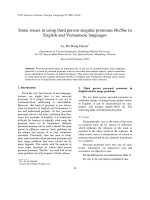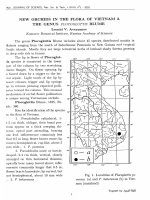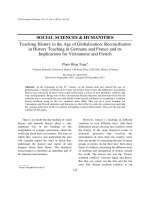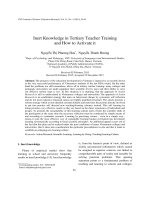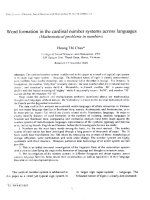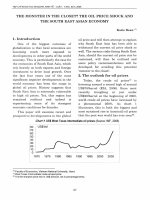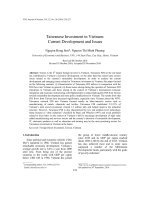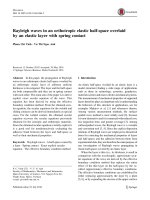DSpace at VNU: Pesticide pollution in agricultural areas of Northern Vietnam: Case study in Hoang Liet and Minh Dai communes (vol 159, pg 3344, 2011)
Bạn đang xem bản rút gọn của tài liệu. Xem và tải ngay bản đầy đủ của tài liệu tại đây (143.71 KB, 1 trang )
Environmental Pollution 206 (2015) 720
Contents lists available at ScienceDirect
Environmental Pollution
journal homepage: www.elsevier.com/locate/envpol
Corrigendum
Corrigendum to “Pesticide pollution in agricultural areas of Northern
Vietnam: Case study in Hoang Liet and Minh Dai communes”
[Environ. Pollut. 159 (12) (2011) 3344e50]
Pham Manh Hoai a, Zita Sebesvari b, Tu Binh Minh a, Pham Hung Viet a,
Fabrice G. Renaud b, *
a
b
Research Center for Environmental Technology and Sustainable Development, Hanoi University of Science, 334 Nguyen Trai Str., Hanoi, Viet Nam
United Nations University, Institute for Environment and Human Security (UNU-EHS), Hermann-Ehlers-Str. 10, D-5311, Bonn, Germany
The authors regret to say that there was a unit conversion error in the calculations and some of the results were reported incorrectly.
Please note that the authors wish to make the following changes to the above paper:
Abstract (last sentence)
Thresholds for acceptable daily intake levels (ADI) might be reached when consumed for a few of the analyzed food products while
typically several pesticides co-occurred in the same sample pointing to the fact that current pesticide management practices do not only
result in a pollution of the environment but may also pose threats to human health.
Section 3.3.1. Recently used pesticides (3rd paragraph)
Since the MRL does not account for health risk, the reported concentrations were compared with the acceptable daily intake (ADI) values
established by the European Food Safety Authority (EFSA) and the WHO/FAO Joint Expert Committee on Food Additives (JECFA). The ADI is a
measure for the toxicity of a substance by long-term and repeated ingestion. Among the studied pesticides ADI was established for
cypermethrin (0.02 mg/kg bw.), cyfluthrin (0.04 mg/kg bw) and trichlorfon (0.002 mg/kg bw) (all ADIs derived from WHO, 2009). A daily
intake of 1 kg of any of the fish samples would be safe i.e. would not reach the ADI for any above-mentioned compounds (calculation for a
person with 50 kg body weight; exception: one fish sample for trichlorfon in which the ADI is reached with the consumption of 390 g fish).
Tea can be considered as safe for use since - assuming again 70% moisture content of the leaves a consumption of ca.19 kg dry tealeaves on a
daily basis would be necessary to exceed the ADI for at least one analyzed pesticide (tea bags usually have 2.5e5 g filling weight). In case of
mugwort, trichlorfon exceeds the ADI by a consumption of 690 g per day while several kilograms of heartleaf and water spinach can be safely
consumed daily. Health risk might be higher when different sources of contaminated food items are consumed and daily intake adds up.
3.3.2. Organochlorine pesticides (1st paragraph)
DDTs, Drins and HCHs were detected in tea, vegetable and fish samples. ADI is established for DDT (PTDT, provisional tolerable daily
intake, 0.01 mg/kg bw), lindane (0.005 mg/kg bw) and aldrin/dieldrin (PTDT, provisional tolerable daily intake, 0.0001 mg/kg bw) (all ADIs
derived from WHO, 2009). Considering again a person with 50 kg body weight a daily intake of 1.2 to 2.9 kg fish would cause that the ADI is
exceeded for all samples for aldrin/dieldrin, while the samples were safe for lindane and DDT. Water mimosa contains aldrin/dieldrin in a
concentration which does not allow for a consumption of more than 280 g per day, while ca. 500 g heartleaf or water spinach can be
consumed without exceeding the respective ADIADI was not exceeded for lindane and DDT in vegetables. Health risk might be higher when
different sources of contaminated food items are consumed and daily intake adds up.
Conclusions (last sentence of 2nd paragraph)
Since acceptable daily intake (ADI) levels were exceeded in some fish and vegetable samples for individual pesticides (depending on
consumed daily amount) while typically several pesticides co-occurred in the same sample, the improvement of pesticide management
practices would be crucial from a human health perspective, particularly in terms of reducing exposure.
We sincerely apologize for the mistake.
DOI of original article: />* Corresponding author.
E-mail address: (F.G. Renaud).
/>0269-7491/© 2015 Elsevier Ltd. All rights reserved.
